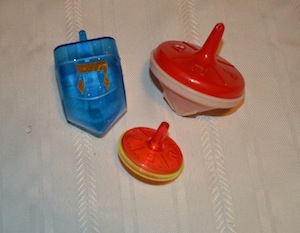Dreidels from the author’s dreidel collection. Clockwise from the top left: a hand-painted dreidel with an open top; a hand-painted dreidel on a base; a felt dreidel; a hand-painted dreidel; and, in the centre, a tiny hand-painted glass dreidel. (photo by Barry Kaplan)
Dreidel is the most popular game for Chanukah. In Hanukkah: Eight Nights, Eight Lights, Malka Drucker writes that it evolved 2,000 years ago when the Chanukah story took place, at a time when Antiochus ruled over Judea in ancient Israel. “Groups of boys who had memorized the entire Torah would secretly study together until they heard the footsteps of the Syrian soldiers. Then they would quickly pull out spinning tops … and pretend to be playing games,” she writes.
Whether this is true or not, we do know that, by the Middle Ages, the game became more complicated, as rules were borrowed from a German gambling game. According to Encyclopedia Judaica, during the long nights of Chanukah, while the lights were burning, it became customary to pass the time by spinning tops and playing the ancient “put and take” game. This was in fulfilment of the commandment that the Chanukah lights should not be used for any utilitarian purpose – “they are only to be seen.”
While playing cards and other games has been prohibited by the rabbis over the years, as the games were considered frivolous because they took away from Torah study, the custom continued.
In medieval Germany, dice were used for the game, and they were inscribed with N, G, H and S. N stood for nichts, nothing; G stood for ganz, all; H was for halb, half; and S meant stell ein, put in. All players would hold an equal number of nuts, raisins or coins. Each player would put one in the middle, and the first player would spin the dice. Each letter stood for a move in the game – putting in or taking out nuts, raisins or coins, according to where the dice landed.
Later, boys carved tops or dreidels out of wood or poured hot lead into a form to make a spinning top. The letters were then changed to Hebrew and said to stand for the Hebrew letters nun, gimmel, hey and shin. The rabbis were less reluctant for boys to play with these tops because the letters were interpreted to stand for the phrase, “Nes gadol hayah sham,” “A great miracle happened there.”

In modern Israel, the Hebrew letter shin is replaced by a peh, standing for poh, meaning here – “A great miracle happened here.”
The rabbis felt even more comfortable about the game when it was also realized that, when the Hebrew letters, which have numerical value, are added together, they total 358, the same number of letters as the word for Messiah. (Nun is 50, gimmel is three, hey is five and shin is 300.) The letters of the word Messiah or Mashiach in Hebrew are mem, which is 40, shin which is 300, yud which is 10 and chet which is eight. Since the Jews are still waiting for the Messiah, this would show the way for a miracle.
Another mystical interpretation of the Hebrew letters is described by Philip Goodman in The Hanukkah Anthology. He writes that nun stood for nefesh (Hebrew for soul); gimmel stood for guf (body); shin stood for sechal (mind); and hey stood for hakol (all), implying all the characteristics of humankind.
Among the most-sung Chanukah songs are those about the spinning top – dreidel, in Yiddish, and s’vivon, in Hebrew.
The origin of the song “I Have a Little Dreidel” – “I have a little dreidel, I made it out of clay, and when it’s dry and ready, then dreidel I shall play!” – was the subject of an interesting article by Melanie Mitzman a few years ago in Hadassah Magazine. She wrote that Joshua Jacobson, a professor of music and Jewish studies at Northeastern University, explained that the song was originally in Yiddish and the opening line was “I made it out of lead.”
Samuel Goldfarb is said to have penned the English lyrics, and Goldfarb, a Jewish liturgical composer employed by the Bureau of Jewish Education of New York between 1925 and 1929, wrote the melody for the English version. Goldfarb’s granddaughter, Susan Wolfe, recalls telling her public school class that her grandfather had written “The Dreidel Song,” but they did not believe her.
The popular Hebrew song for this game is “S’vivon”: “S’vivon, sov, sov, sov. Chanukah hu chag tov,” “Spinning top, turn, turn, turn. Chanukah is a good holiday.”
As for dreidel games, here are the rules for three.
Put and take
On the sides of the dreidel are the four letters described above. To play the game, each player puts in one or more nuts or coins as agreed. A player spins the dreidel. If it falls on N, the player does nothing. If it falls on G, the player gets all. If it falls on H, the player takes half. If it falls on S, the player takes the whole pot. The next player takes their turn after each player once again contributes to the pot.
Endurance
All players spin the dreidel at a given signal. The player whose dreidel spins the longest is the winner.
Play for score or time
This game uses the fact that each Hebrew letter of the dreidel has a numerical value: N = 50, G = 3, H = 5 and S = 300. Players agree on a specific score to reach or time in which to play. Each player spins the dreidel. The scorekeeper credits each player with the numerical value of the letter on which his or her dreidel falls. The game continues until a player reaches the agreed-upon score or until the allotted time has passed, in which case the player with the most points wins.
Sybil Kaplan is a journalist, foreign correspondent, lecturer, food writer and book reviewer who lives in Jerusalem. She also does the restaurant features for janglo.net and leads walks in English in Jerusalem’s market.

